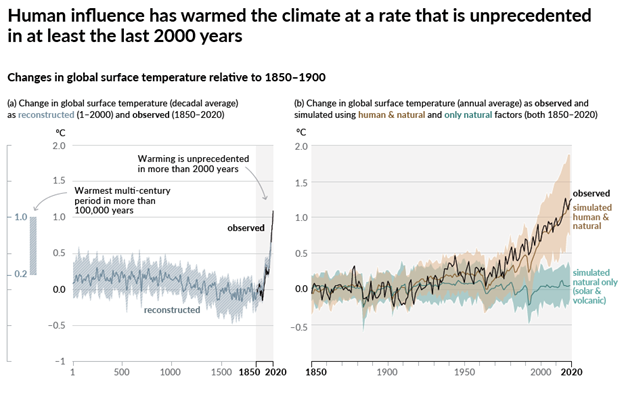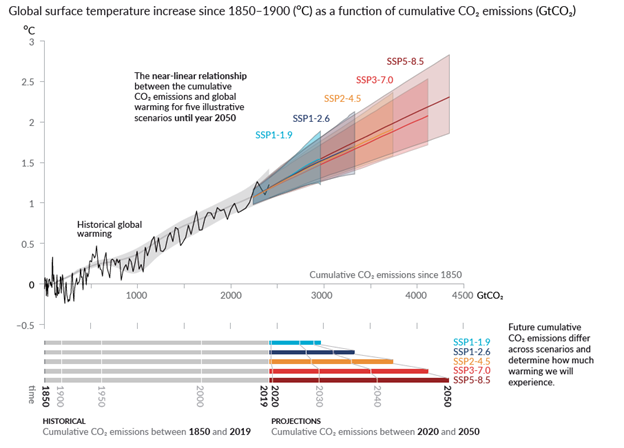Top takeaways:
- The Earth’s climate has warmed at a rate that is unprecedented in the last 2000 years, largely due to the unequivocal influence of human activities such as the burning of fossil fuels and land use changes.
- Global temperatures and precipitation are projected to increase over the 21st Century, with some regions seeing more dynamic changes than other. For example, Canada is warming twice as fast as the global average and faces both flooding and drought risks in different regions.
- Global changes have important implications for businesses in the GTA through the inextricable links and interdependencies of global supply chains.
The Global Surface Temperature is Rising
The Intergovernmental Panel on Climate Change (IPCC) is the United Nations body for assessing the science related to climate change. The IPCC has found that it is indisputable that human activity such as the burning of fossil fuels and destruction of the natural landscape has caused unprecedented changes in the Earth’s climate[1].
Using proxy data such as ice cores, the IPCC reconstructed global surface temperature and found that the scale of recent (1850-2020) temperature changes is unmatched over the last 2000 years (Figure 1). Global mean surface temperature has already warmed by approximately 1.1°C since the pre-industrial period (1850-1900). In fact, the last eight years have been the warmest on record since record keeping began in 1880[2]. This warming is already affecting many weather and climate extremes in all parts of the world[3].

What does this mean for the future?
The IPPC has projected possible climate futures based on different social and economic choices. There are five future scenarios, referred to as Shared Socio-Economic Pathways (SSPs) that range from very high to very low GHG emissions scenarios [3]. These SSPs, are not predictions of the future climate, but instead provide “what-if” simulations of possible futures that may result from our actions or inactions. The IPCC warns that with every additional increment of global warming, the Earth’s climate will get even hotter, wetter, and wilder, leading to more devastating impacts on human and natural systems. For more context on the IPCC’s SSPs, check out this interactive chart from Our World in Data and learn more about the different socio-economic assumptions in each scenario.
The Paris Agreement, which has been adopted by 196 international Parties, including Canada, recognizes that limiting global warming to a 1.5°C increase above pre-industrial levels would significantly reduce the risks and impacts of climate change compared to a 2°C increase. Only the very low emissions scenario (SSP1-1.9) is expected to limit global warming to below 1.5°C by the end of the century. Even under this most optimistic IPCC scenario, 1.5°C will still be exceeded temporarily this century (Figure 2)[3].
Across all five scenarios, global temperatures are projected to reach 1.5˚C much sooner than originally anticipated. By the end of the century, most scenarios exceed 2˚C of global warming, except the low and very low emissions scenarios. Both the low and very low emissions scenarios assume net-negative emissions, meaning that they incorporate carbon capture and storage (CCS).
The very low emissions scenario demonstrates that global warming can be limited to below 1.5˚C if we halve GHG emissions by 2030, reach net-zero by 2050, and achieve negative emissions thereafter. However, without rapid and sustained economic and social transformation, global warming could exceed 4.4°C by the end of the century, which would lead to further widespread and irreversible changes and make more regions of the world uninhabitable.

Global Precipitation Patterns
In addition to rising temperatures, global precipitation patterns are also projected to change dramatically with human-caused climate change[1].
Warmer air holds more water vapour to produce storms, leading to more variable and intense precipitation. The IPCC projects that with every 1°C of global warming, extreme daily precipitation events will intensify by 7%. At future temperatures of 1.5°C warmer, a once-in-a-10-year storm will occur 1.5 times more often and be 10.5% wetter[1].
In general, wet regions are expected to get wetter and dry regions are expected to get drier. Precipitation is expected to increase at higher latitudes, the equatorial Pacific, and parts of the monsoon region such as east Africa and India, while in other regions such as the subtropics, precipitation is projected to decrease by 10-30%[1]. This has important implications for global supply chains as changing global precipitation patterns will impact where and how much water can be used for industries and agriculture. For prescription changes expected in the GTA, please see Primer: Changes in Precipitation in Toronto Region over the 21st Century.
Though global average temperature and precipitation are projected to increase over this century, changes at the regional level will be much more dynamic. Landmasses, particularly at higher latitudes, are expected to continue to warm faster than ocean areas[1]. According to Canada’s Changing Climate Report, Canada is warming at twice the global rate, with some areas in the north warming three times as fast. Several climate processes and feedbacks may be driving this trend. For example, loss of snow and sea ice is reducing the amount of solar radiation that is reflected off the surface and increasing the amount being absorbed.
Total precipitation is predicted to increase for most of the country, with summers expected to see a decrease in rainfall in some areas[4]. These changes have local impacts, which vary across Canada and around the world. It is therefore important to understand the specific risks posed by climate change at the local and regional level and at the scale that businesses operate.
Bottom Line
Based on this information, we know that the temperature and precipitation levels will continue to change in harmful ways, and we will continue to see increasingly severe impacts from these changes. If this knowledge is translated into action, businesses can ensure they not only survive, but thrive in the coming decades.
Partners in Project Green’s Building a Climate Resilient Business Resource Kit provides a foundation in the basics of current climate science, the impacts of climate change on businesses, and mitigation and adaptation strategies. Please explore these resources and connect with us to advance your organization’s climate resiliency.
To learn about the impacts of climate change on business, check out:
- Impact: Human Health
- Impact: Buildings and Infrastructure
- Impact: Agriculture and Food Security
- Impact: Supply Chain
- Impact: Financial and Regulatory
[1] IPCC. 2021. Summary for Policymakers. In: Climate Change 2021: The Physical Science Basis. Contribution of Working Group I to the Sixth Assessment Report of the Intergovernmental Panel on Climate Change [Masson-Delmotte, V., P. Zhai, A. Pirani, S.L. Connors, C. Péan, S. Berger, N. Caud, Y. Chen, L. Goldfarb, M.I. Gomis, M. Huang, K. Leitzell, E. Lonnoy, J.B.R. Matthews, T.K. Maycock, T. Waterfield, O. Yelekçi, R. Yu, and B. Zhou (eds.)]. Cambridge University Press, Cambridge, United Kingdom and New York, NY, USA, pp. 3−32, doi:10.1017/9781009157896.001.
[2] Bates, S. & Carlowicz, M. 2021. 2021 Continued Earth’s Warming Trend. Nasa Earth Observatory. URL: 2021 Continued Earth’s Warming Trend (nasa.gov).
[3] IPCC. 2021. Climate Change 2021: The Physical Science Basis. Contribution of Working Group I to the Sixth Assessment Report of the Intergovernmental Panel on Climate Change[Masson-Delmotte, V., P. Zhai, A. Pirani, S.L. Connors, C. Péan, S. Berger, N. Caud, Y. Chen, L. Goldfarb, M.I. Gomis, M. Huang, K. Leitzell, E. Lonnoy, J.B.R. Matthews, T.K. Maycock, T. Waterfield, O. Yelekçi, R. Yu, and B. Zhou (eds.)]. Cambridge University Press, Cambridge, United Kingdom and New York, NY, USA, In press, doi:10.1017/9781009157896.
[4] Zhang, X., Flato, G., Kirchmeier-Young, M., Vincent, L., Wan, H., Wang, X., Rong, R., Fyfe, J., Li, G., Kharin, V.V. 2019. Changes in Temperature and Precipitation Across Canada; Chapter 4 in Bush, E. and Lemmen, D.S. (Eds.) Canada’s Changing Climate Report. Government of Canada, Ottawa, Ontario, pp 112-193.

